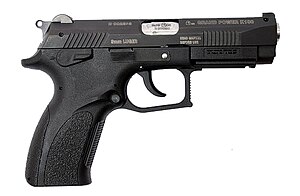Grand Power K100: Difference between revisions
mNo edit summary |
|||
| Line 63: | Line 63: | ||
==External links== |
==External links== |
||
{{Commons|Category:Grand Power|Grand Power}} |
{{Commons|Category:Grand Power|Grand Power}} |
||
* [http://www.dogswar.ru/strelkovoe-oryjie/pistolety-revolvery/4057-pistolet-grand-power.html Grand Power K100 Information] |
|||
*[http://www.grandpower.eu/Download_subory/G&A_3_2004.pdf K100 Action Expose] |
*[http://www.grandpower.eu/Download_subory/G&A_3_2004.pdf K100 Action Expose] |
||
*[http://www.grandpower.eu Grandpower Homepage] |
*[http://www.grandpower.eu Grandpower Homepage] |
||
Revision as of 09:29, 10 April 2011
| K100 | |
|---|---|
 Grand Power K100 Mark 6 | |
| Type | Semi-automatic pistol |
| Place of origin | |
| Production history | |
| Designer | Jaroslav Kuracina |
| Designed | 1994–1996 |
| Manufacturer | Grand Power |
| Produced | 2002–present |
| Variants | K100 Tactical, K100 Mark 6, K100 DAO, K100 QA, K100 Target, GPC9, K100 Whisper, K102 R, K105 R, P1 |
| Specifications | |
| Mass | Template:G to oz |
| Length | Template:Mm to in |
| Barrel length | 108 mm (4.3 in) |
| Width | 40 mm (1.6 in) |
| Height | 133.5 mm (5.3 in) |
| Cartridge | 9x19mm Parabellum |
| Action | Short recoil operated, rotating barrel |
| Feed system | 17-round detachable box magazine |
| Sights | Fixed, front blade and adjustable rear notch 160 mm (6.3 in) sight radius |
The K100 is a 9 mm semi-automatic pistol designed and built by Grand Power s.r.o. in Banská Bystrica, Slovakia.
Development
The K100 was developed by Jaroslav Kuracina, a former weapons officer in the Slovak Army. Kuracina sketched drawings of the K100 as early as 1992, but manufacturing activities were highly restricted during the early post-Communist era. Kuracina would be forced to wait until 1996 to continue development of his design. In September 2006 Grand Power announced a deal to produce 100,000 units for the U.S. market in partnership with Texas-based handgun manufacturer STI International Inc.[1] The pistol is sold as the GP6.[2]
Design details



The K100 uses a rare locking system, similar in some ways to the Beretta Cougar, Px4 Storm, and Brügger & Thomet MP9 which employs a rotating barrel lock, which in the K100's case is cammed by a cross pin. When the pistol is fired the barrel and slide move backward together for about 3/8ths of an inch while the barrel is cammed counterclockwise by a flat, twisting, helical "cut" in the barrel extension. Once the barrel and slide have moved back to the point where the barrel has twisted about 45° to the left, the slide is free to continue traveling back while the barrel's travel is arrested by its interface to the frame via the barrel extension's square shoulders. On the K100, the Beretta's barrel extension cam cut, and transfer block's cam tooth, are replaced by a curled, twisting cut in the barrel extension, and a round, frame-embedded cross-pin respectively. As such, there is no transfer block per sec, and the barrel extension directly interfaces with the frame via the replaceable cross-pin.
Both of the Berettas, and the K100, have the archetypal square shouldered lock protruding from the otherwise round barrel, easily visible at the ejection port with the slide fully forward. This square shoulder is rotated in behind a solid column of steel running the length of the slide forward of the ejection port, and on the left side out of view, when the slide and barrel are fully forward in battery. This locks the slide forward in battery. Given that the MP9 uses the same basic locking mechanism, and has a cyclical rate of fire of 900 rounds/min, the rotating barrel lock has shown itself to be capable of very fast lock times.
The thick walled barrel and other metal parts are treated by Tenifer QPQ technology. This hardens the metal components and increases resistance to corrosion.[3]
The standard K100 has a barrel length of 108 mm (4.3 in) and operates in both single and double action mode.
The ergonomically shaped polymer frame is fitted with steel inserts the slide travels on, and where hardpoints are required for the trigger mechanism. The slide spring guide, safety, trigger, and trigger guard are polymer.
The pistol's toothy surface, and grooved grips, provide good grip even with wet hands. The K100 also features ambidextrous controls, supporting both left and right-handed users. When field stripping, the slide moves to the rear, up and off the frame.
